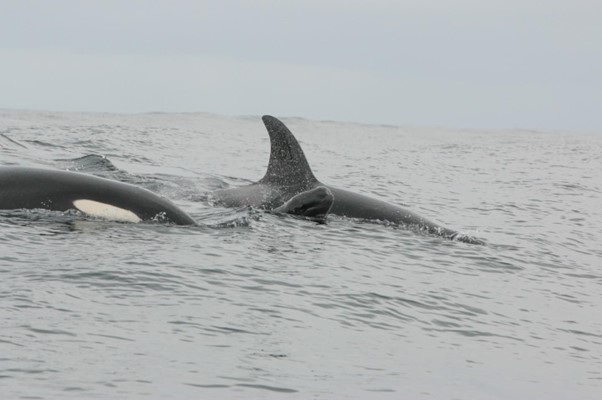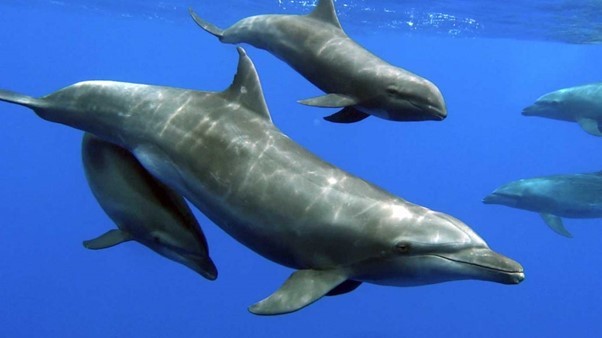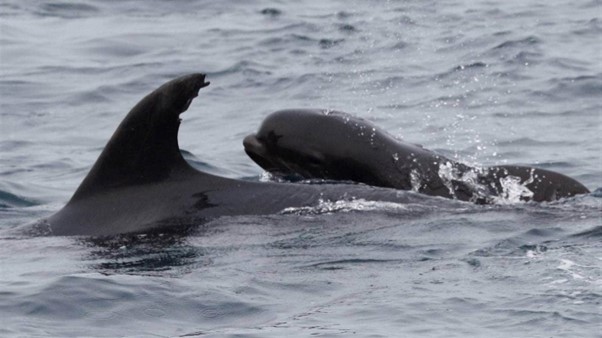What is a pod of killer whales doing with pilot whale calf?
That is the question on everyone’s mind. The newly published paper (Selbmann et al.2022), the interspecies interactions between killer whales and long-finned pilot whales in Icelandic waters, revealed a complex social relationship. However, a new development has come to light, as a female killer whale and her pod were recently seen with a pilot whale calf amongst them. There were no pilot whales in sight and thus this occurrence has puzzled scientists.
Killer whales, the notorious apex predators of the marine environment, are known for their extraordinary hunting skills and high intelligence. The recent paper (Selbmann et al.2022), describes years’ worth of studies of the complex interactions between killer whales and pilot whales in Icelandic waters. In most cases, where both species were sighted simultaneously, the killer whales generally demonstrated avoidance behaviour (often at high speed) away from the pilot whales, when they approached. However, in some cases, the killer whales had no visible reaction. This is the first study where the intensity of the interactions varied between the two species, thus the social relations between the two, are far from fully understood.
Mid-sized pods are the most social
Previous research into social cognition and intelligence among cetaceans, has revealed fascinating links to brain size, social grouping, and the geographical range of these species.
A study published in Nature in 2017 established a significant relation between pod size, brain size and social behaviour. In fact, the study showed that cetaceans who generally occur in what is known as ‘mid-sized pods‘, such as killer whales and bottlenose dolphins, rank higher in both brain size (relative to body) and social behaviours, than cetaceans who are mostly solitary, (e.g. blue whales) and cetaceans who live in ‘megapods’ such as pilot whales (Fox et al. 2017). The study further goes on to categorising each species observed behaviour in a social repertoire ranking system. Such behaviours include among others ‘alloparenting’. Among the highest-ranking species within these behaviors, is the killer whale.
Comparable to humans?
Have you ever heard of spindle neurons? They are a special type of nerve cells, found in the brain of mammals. In a mammalian brain, spindle neurons are part of the limbic system, which is involved in emotional processing and regulation. Spindle neurons were previously believed to be unique to only humans and great apes. However, cetaceans also have a large number of spindle neurons, making them highly empathic, emotional intelligent and capable of forming complexed social structures, which are far from fully understood.
Finally, cetaceans surpass humans when it comes to certain neurological complexities of the brain and rank second to humans, in brain size/body size ratio (Marino et al. 2007)!
Strong family bonds
So far it is unclear as to why exactly a pilot whale calf is seemingly the newest member of a killer whale pod. However, one can certainly draw lines to their highly evolved social cognition and past examples of similar incidents as previously described here https://www.seawatchfoundation.org.uk/interspecies-adoptions/) exhibited by other ‘mid-sized’ pod associations. Likewise, a similar case was seen last year by ‘Orca Guardian Iceland’ of a killer whale pod with a pilot whale calf. Long-finned pilot whales and resident-ecotype killer whales, which are both members of the dolphin family and characterized as toothed whales, have very similar social structures (Mann et al. 2019). Where most other cetacean species break out to form their own pod once sexual maturity is reached, both species form strong family bonds. They live in a ‘Matriarch’ type of social structure, where the oldest female is in charge. In fact, female killer whales continue to live approximately 40 years after their reproductive years are over (into their 80’s!).
The Grandmother Effect
Sounds familiar? Much like humans and a few other cetacean species, females go through menopause. However, despite no longer having a reproductive purpose, their sole purpose becomes the role of caring for their pod with their life-long experiences. In humans, this is referred to as the “grandmother effect” and is believed to be the reason why women live beyond their reproductive years (Nattras et. al. 2019). This is a rare adaptation in nature and one that can only be assumed to have evolved for the benefit of a species’ survival. Another study showed that this strong social bond becomes the very difference between life or death for the resident-ecotype killer whales in British Columbia. The study demonstrated the increase in survival of offspring if the Matriarch lived to be the leading and nurturing force of her pod (Nattrass et al. 2019). While inter-specific alloparenting in killer whales is a known phenomenon, intra-specific alloparenting is not. Did the killer whales perhaps adopt the pilot whale calf, when it became separated from its own pod? Despite the very complex and seemingly unfriendly relations between the two species, perhaps the strong sense of family social structure and high level of empathy gave this pilot whale calf a second chance in life.
Rebecca Valani Research Assistant
References
Fox K.C.R, Muthukrishna M and Schultz S. 2017. The social and cultural roots of whale and dolphin brains. Nature, evolution and ecology. 1(11).
Kenkel WM, Perkeybile AM, Carter CS. The neurobiological causes and effects of alloparenting. Dev Neurobiol. 2017 Feb;77(2):214-232. doi: 10.1002/dneu.22465. Epub 2016 Nov 25. PMID: 27804277; PMCID: PMC5768312.
Mann, J. (2019). Maternal Care and Offspring Development in Odontocetes. In: Würsig, B. (eds) Ethology and Behavioral Ecology of Odontocetes. Ethology and Behavioral Ecology of Marine Mammals. Springer, Cham. https://doi.org/10.1007/978-3-030-16663-2_5
Marino, L. et al. 2007. Cetaceans have complex brains for complex cognition. PLoS Biol. 5, e139
Nattrass S, Croft D.P, Ellis S, Cant, M.A, Weiss M.N, Wright B.M, Stredulinsky E, Doniol-Valcroze T, Ford J.K.B, Balcomb K.C and Franks D.W. 2019. Postreproductive killer whale grandmothers improve the survival of their offspring. Proc. Natl Acad. Sci. USA. 116
Selbmann A., Basran C.J., Bertulli C.G, Hudson T., Mrusczok M-T., Rasmussen M. H, Rempel J. N., Scott J., Svarvarsson J., Wensveen P.J., Whittaker M., Samarra F.I.P. 2022. Occurence of long-finned pilot whales (Globicephala melas) and killer whales (Orcinus orca) in Icelandic coastal waters and their interspecific interactions. Acta ethologica.



























